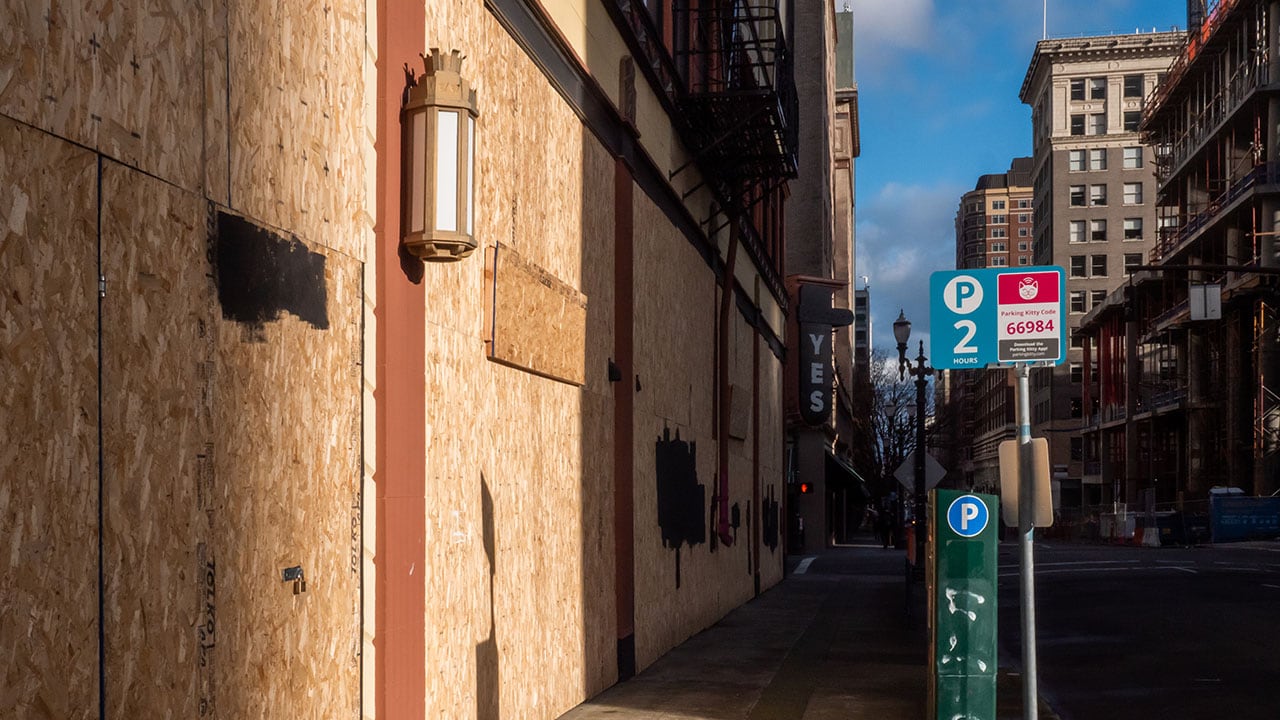The image of downtown Portland is painted on plywood.
The murals on boarded-up shop windows portray the kind of city Portland wants to be: just, equitable, harmonious.
The need for those boards reveals who we are now: acrimonious, divided, fearful of each other and our future.
Portland is nearing the one-year anniversary of the COVID-19 pandemic descending on the city. It is also engaged in an increasingly desperate conversation about whether, even after the plywood comes down, downtown can thrive again.
No other part of Portland has been so obviously altered. In March, most of the city's largest employers sent their office workers home, leaving towers empty. Few of them have asked employees to return.
Other workers lost their jobs entirely—and people already living on the precipice of poverty fell in. Their tents line the streets of downtown, replacing pedestrians and food vendors on the sidewalks.
Then, in late May, the downtown filled up again—with heartbroken and enraged people grieving the death of George Floyd and demanding reform and the defunding of the Portland Police Bureau. The most strident of these protesters have repeatedly turned to vandalism. The damage to shops and Portland's reputation made recovery that much harder.

Lately, the naysayers are dancing on downtown's grave.
A Lake Oswego economist named Bill Conerly asked in a Forbes.com essay last month whether Portland would join the ranks of once-thriving cities that are now empty husks. He even compared Portland to Pompeii, fitting the apocalyptic tone of recent media coverage—much of it, to be clear, promoted by Fox News and its brethren who delight in Portland's struggles.
The paralysis and fracturing of downtown Portland is now a national story, even if only parts of the myth are true.
When Portland's racial justice protests continued long after other cities quieted, President Trump sent in federal police, and right-wing pundits recycled explosive images. None of this was new, but it stuck—thanks to images of tear gas wafting through the streets and protesters trying to tear down federal fencing. To cable news junkies, the city was a war zone and a meme.
But the story of Portland's downtown is not just a battle about who gets to define the city. It's a neighborhood story.

One of the decisions that defined modern Portland was the choice by city leaders in the 1970s to treat downtown as a neighborhood—not just a center for commerce that emptied out each night, but a place where people lived. That vision inspired Pioneer Courthouse Square, "the city's living room."
Downtown is so central to our civic identity that it is hard to accept that its recovery may not be linked as closely to the city's reputation as we think.
Even as downtown has suffered in 2020, residential real estate prices are soaring and inventory has never been lower. Data shows that the in-migration that drove the city's growth is continuing, even amid a homeless crisis that predated the pandemic, tax increases and tear gas.

The qualities that made Portland attractive before the pandemic and civil unrest still exist. John Tapogna, president of the consulting firm ECONorthwest, notes that many of Portland's peers also are struggling, and acknowledges that restoring Portland to health will require skillful guidance by state and local leaders. But he says the outcome of the pandemic—fewer hospitalizations and deaths than nearly any other state or city—demonstrates our officials can tackle daunting challenges.
"We've got an awful lot of advantages over cities that have failed in the past," Tapogna says. "Our foundational capital is still there."
So what remains? Over the past week, WW did what pundits won't: We spent our days and nights in downtown Portland. We trudged through snow and ice to visit Plaid Pantrys, got on the phone with the people who know the neighborhood best, and pored through public records.
In the following pages, we show you what we found.
We encountered a place that is reeling but resilient. And we met people who are tired of being used as fodder for outsiders' narratives. To them, downtown isn't a stage to score political points—it's their home. They want the city to work. And behind the plywood, they are keeping downtown alive.
One Night With the Man Who Puts Plywood on Portland's Smashed Windows
Forget Pompeii. Is Portland the Next Detroit?
Who Knows What Downtown Portland Is Really Like? The People Working the Cash Registers.
Seven Charts Explain Downtown Portland's Precarious Moment—and Why the Future Isn't So Dire

